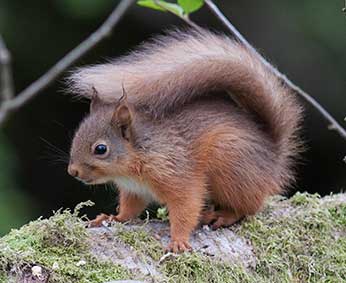Red squirrels in the New Forest

Red squirrels were once abundant in the New Forest, but by the 1940s they had been replaced by their grey cousins from America. Absence, though, has made the heart grow fonder, and through the rose-tinted spectacles of time, red squirrels are now somewhat revered.
But in days gone by, New Forest red squirrels were ruthlessly killed as enemies of the forester, for sport and for the pot.
John Wise writing in the early 1860s, and Gerald Lascelles, Deputy Surveyor of the New Forest, writing of the years between 1880 and 1914, noted a range of weaponry used to bring down red squirrels from the tree-tops during the old sport of squoyling. Scales, squoyles, squails and snogs - the names seem to have been interchangeably used - were relatively light sticks around 38 centimetres (15 inches) long, loaded at the tip with a pear-shaped ball of heavier, hard wood; and stouter sticks of similar length, loaded with lead.
At times, squoyling was a competitive social activity that seems to have been particularly well-supported around Christmas-time when squoyling parties would go out into the woods to see which would come back with the biggest bag of squirrels.
Yes, these were tough days for red squirrels, for when not being subjected to the sporting scale, squoyle, squail or snog, they were severely culled as forestry pests – in 1889 alone, over two thousand red squirrels were reported shot. Not surprisingly, Lascelles noted that numbers were nowhere near as great as previously, but, maybe disingenuously, attributed the decline to an epidemic.
Were red squirrels ever used for the pot? Yes, certainly. They were often abundant, relatively easily killed, did not enjoy the protection from poaching offered to the local deer, and in the New Forest were reputed to be ‘finer, fatter, bigger and with better fur’ than in most places elsewhere.
Indeed, Wise recorded bags of 100 or more squirrels brought home and baked in a pie, whilst Lascelles noted that ‘great congregations of red squirrel hunters about Christmas time all met together in the evening at one or other local public house, and enjoyed great suppers of red squirrel pie, the product of the day’s amusement.’
Red squirrels were also a favourite foodstuff of gypsies who in those days roamed the area, and, undoubtedly, the families’ of many a commoner and Crown official would also have enjoyed their share of the spoils.
Writing of the early 1900s, retired New Forest keeper Gilbert Smith recalled: ‘We looked forward to Boxing Days to go squirreling. Not after the grey tree rats we see in the New Forest today, but that gorgeous creature that we see here no more, the red squirrel. The red squirrel could never be described as vermin but their numbers had to be controlled otherwise the young bucks in June would tear about the trees, particularly the larch, and rind the top with the result that the tree died. We went after the red squirrels armed with snogs – lethal weapons made from pieces of wood with a lead weight wired on the end. These would be used to knock the red squirrels from the trees and when we had about a dozen we would take them home to be skinned and cooked in the turf oven. They made a very tasty meal.’
After the Second World War, when food was severely rationed, the government positively encouraged use of red squirrels as a pie filling, and even provided recipes. It was reported, though, that ‘Red squirrels were non-too tasty, whilst grey squirrels provided a sweet, succulent meal, especially when marinated in olive oil, with salt, pepper and a squeeze of lemon juice; and then grilled.’
Many people today, though, would probably not like to try either variety.
Find out more about New Forest squirrels
References:
The New Forest: Its History and Scenery: John R. Wise.
Thirty-five Years in the New Forest: Gerald Lascelles.
Gilbert Smith, New Forest Recollections
More links
Other related links
Search this site

Sadly, 58 animals were killed - 35 ponies, 13 cows, 8 donkeys and 2 sheep, whilst a further 32 were injured - 3 pigs, 9 donkeys, 11 cows and 9 ponies.
(Forty-three accidents occurred in daylight, 15 at twilight and 101 in the dark. Twenty-seven accidents were not reported by the driver involved).
Here's just one horrific example - Three donkeys killed in collision with van at notorious New Forest blackspot (Advertiser and Times)

